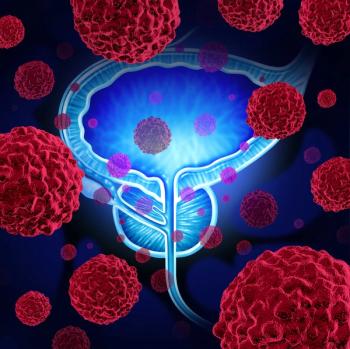
Similar OS and Transplantation Observed With Decitabine vs Chemo in Geriatric AML
Older patients with acute myeloid leukemia who were treated with decitabine experienced comparable outcomes vs daunorubicin and cytarabine.
In addition to an improved safety profile, treatment with decitabine resulted in a similar rate of overall survival (OS) and hematopoietic stem cell transplantation (HSCT) vs a chemotherapy regimen consisting of daunorubicin and cytarabine (Vyxeos) in an older population with acute myeloid leukemia (AML).
Findings from a phase 3 study (NCT02172872) that were presented at the
Among those who received on-protocol HSCT, the 1-, 2-, 3-, and 4-year OS rates were 66%, 56%, 50%, and 45% in the experimental arm compared with 75%, 58%, 51%, and 47%, in the chemotherapy arm, respectively. Although a longer OS was observed in patients 70 years or older treated with decitabine (HR, 0.84; 95% CI, 0.55-1.26), those who were 60 to 64 years (HR, 1.34; 95% CI, 0.79-2.28) or who were NPM1 mutant (HR, 2.0; 95% CI, 0.96-4.17) had a worse OS following treatment with the agent.
A total of 606 patients with newly diagnosed or de novo/secondary untreated disease were included in the study. Patients were required to be at least 60 years of age and candidates for an intensive 3+7 chemotherapy regimen. Moreover, at randomization, white blood cell counts couldn't be more than 30 x 109/L. Those who enrolled were randomly assigned 1:1 to receive either the 10-day decitabine regimen (n = 303) or intensive chemotherapy (n = 303).
The trial's primary end point was OS, and key secondary end points included complete response (CR) and CR with incomplete count recovery (CRi), progression-free survival, disease-free survival, transplantation rate and outcome, and safety profile.
In terms of other study findings, the 4-year relapse/progressive disease rates were 57% and 51% in the decitabine and chemotherapy arms, respectively. Moreover, the respective treatment-related mortality rates were 21% and 25% in both respective arms.
Patients treated in the experimental arm had a lower incidence of grade 3 to 5 adverse effects (AEs) vs the chemotherapy arm, including a lower rate of blood and lymphatic disorders, infections, and gastrointestinal disorders. Notably, following HSCT, 25% of patients in the decitabine arm developed grade 5 treatment-related AEs vs 22% of those in the chemotherapy arm.
Reference
Lübbert M, Wijermans P, Kicinski M, et al. 10-day decitabine versus conventional chemotherapy (“3+7”) followed by allografting in AML patients ≥60 years: a randomized phase III study of the EORTC Leukemia Group, CELG, GIMEMA and German MDS Study Group. Presented at: EHA 2022 Hybrid Congress; June 9-12, 2022; Vienna, Austria. Abstract S125.
Newsletter
Stay up to date on recent advances in the multidisciplinary approach to cancer.

























































































